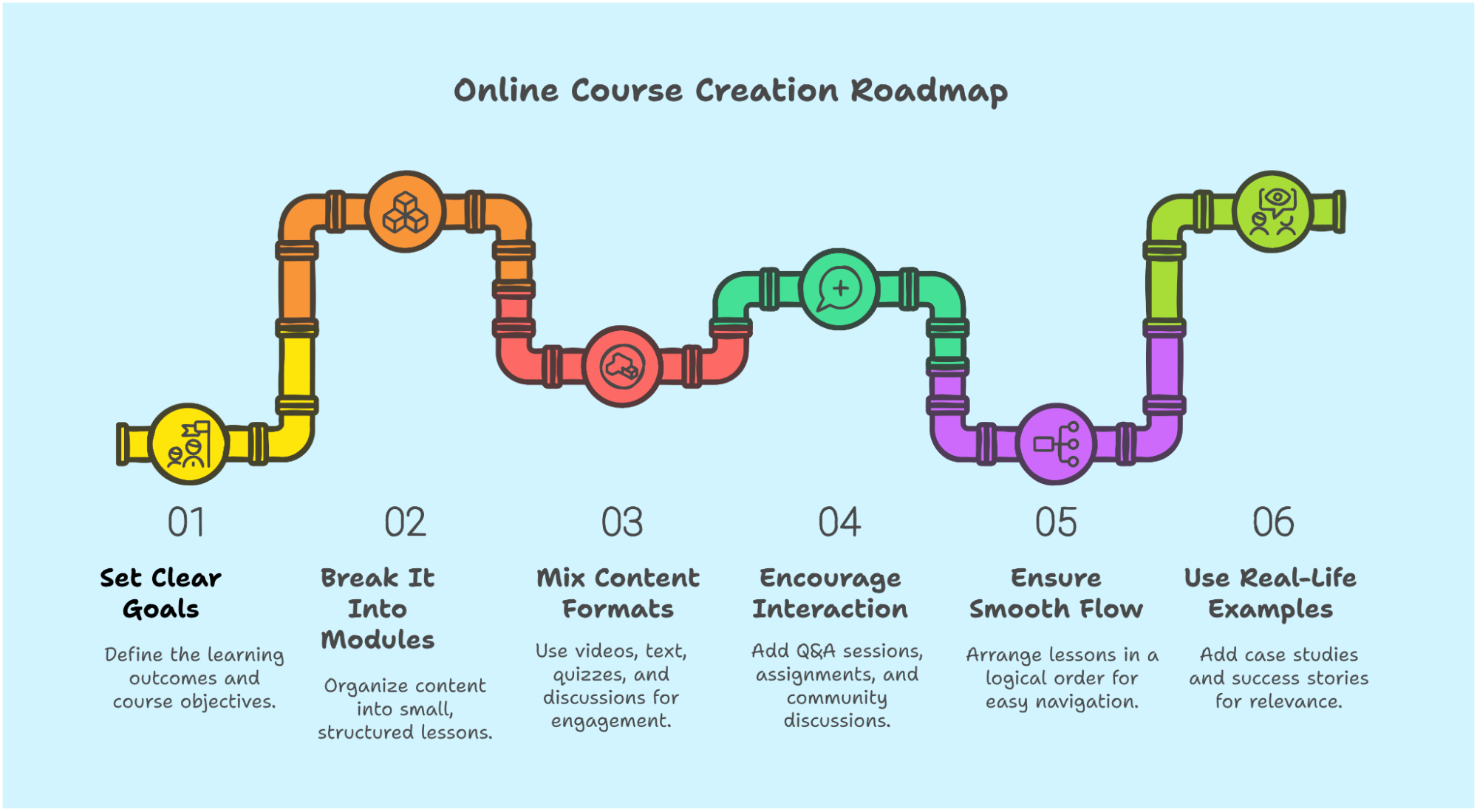A well-planned course structure keeps students interested and engaged. Without structure, learners may feel lost. A clear framework helps them stay on track and excited to learn.
Online course engagement depends on how lessons flow. Organized content makes it easier for students to absorb information.
When modules build on each other, learning feels natural and rewarding. A great structure also improves motivation. Students feel progress when lessons are well-paced and interactive.

Download Your Free e-Book
5 Simple Ways to Create Website & Landing Pages
Affiliate Disclaimer: I earn commission (get paid) if you click on the links and purchase a product below. My earnings do not impact the price you pay.
Breaking content into manageable sections prevents burnout and keeps energy high. Engagement grows when students know what to expect.
Clear goals and structured activities make learning enjoyable. When a course feels smooth, students stay committed. A strong course structure boosts retention and success.
It transforms an ordinary course into an engaging learning experience. Want to create a course that keeps students interested? Let’s explore the best ways to structure it!

Step 1: Start with a Clear Goal for Your Course
Before creating content, set course goals that define its purpose. A strong goal keeps the structure focused and effective.
Ask yourself: What should students learn by the end? Clear online course objectives make lesson planning easier. When students know the learning outcomes, they stay engaged.
A well-defined goal also helps you design activities and assessments. If the goal is clear, every lesson will support it. Without one, the course may feel unorganized or confusing.
To keep students interested, ensure the goal is specific and achievable. Avoid broad objectives that lack focus. The more precise the goal, the better the learning experience.
A well-structured course always starts with a clear purpose. Define your learning outcomes, and the rest of the course will fall into place.

Step 2: Break the Course Into Small, Manageable Lessons
A long, unstructured course can overwhelm students. Breaking it into small course lessons keeps learning simple and engaging.
Use a module breakdown to organize content into logical sections. Each module should cover one key topic or skill. This makes it easier for students to follow the flow.
Short lessons help students absorb information faster. If lessons are too long, they may lose interest. Keep them short and easy to improve retention and engagement.
A good easy course structure includes clear lesson titles and objectives. Students should always know what’s next and why it matters.
Smaller lessons also allow flexibility. Students can learn at their own pace without feeling rushed. Want an engaging course? Break it down into structured, bite-sized lessons.

Step 3: Use Different Formats to Keep It Fun
People learn in different ways. Some prefer watching, while others like reading. Using a mix of course formats makes learning more enjoyable.
Video vs text: which works best? Videos explain complex topics visually, while text allows self-paced reading. Both should be used to cater to different learning styles.
To boost engaging course content, add quizzes, PDFs, and discussions. Interactive activities keep students involved and make learning memorable.
Don’t rely on just one format. Combining different course formats keeps students engaged. A well-balanced mix creates a dynamic learning experience.
The key to a fun course is variety. Mix videos, text, and interactive elements to keep students interested. Here’s a chart idea comparing different course formats based on key factors:
| Format | Best For | Pros | Cons |
| Video | Visual learners, demos | Engaging, easy to follow, personal touch | Time-consuming to produce, larger file size |
| Text | In-depth explanations, reference material | Easy to scan, low production cost | Less engaging, requires strong writing skills |
| Printable guides, worksheets | Portable, structured format, easy to share | Limited interactivity, static content |
Step 4: Keep the Course Flow Smooth and Easy to Follow
A well-structured course should feel like a journey, not a maze. Smooth course flow helps students stay focused and engaged.
Organize content in a logical order, so lessons build on each other. Avoid jumping between topics without a clear connection.
An organized course guides students step by step. They should always know what’s next and why it matters. Using pre-made templates can help create a clear course journey.
Platforms like Kajabi and Leadpages offer well-organized course structures. A messy course confuses students, making them lose interest.
Keep lessons structured to improve learning and retention. Want a course that feels effortless? Focus on smooth flow and clear organization.

Step 5: Add Real-Life Examples and Case Studies
People learn best when they can relate to the content. Real-life examples make lessons more practical and engaging. A great way to teach is through case studies.
They show how concepts work in real situations. This helps students apply what they learn. Encourage students to share their own course success stories.
Learning from real experiences makes topics more meaningful. Using industry examples can make complex ideas easier to understand.
Stories create an emotional connection and boost engagement. The best courses feel relevant and relatable. Use real stories to make lessons unforgettable.
Step 6: Ask for Feedback and Keep Improving
A great course always evolves. Course feedback helps improve lessons and keep students engaged.
Encourage students to share what worked, what didn’t, and what they’d like next. Honest student reviews highlight areas for improvement.

Improve course engagement by refining content based on feedback. Small tweaks can make a big difference. Use surveys, polls, or live Q&A sessions to gather insights.
The more you listen, the better the course becomes. A course should grow with its students. Keep improving to deliver the best learning experience.

Conclusion
Creating an engaging course isn’t a one-time task. It’s an ongoing process. To keep students engaged, always look for ways to improve.
A great course evolves based on student needs and feedback. Small changes can improve an online course and make learning more enjoyable.
Engaging course design focuses on clarity, structure, and variety. When lessons flow smoothly, students stay motivated.
Try new teaching methods, add interactive elements, and refine content. The more engaging the course, the better the learning experience.
Never stop learning about how to make your course better. The best instructors grow alongside their students. Keep improving, keep engaging, and keep inspiring for a successful course.






